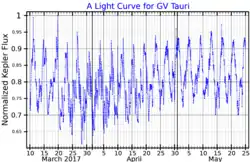| Observation data Epoch J2000 Equinox J2000 | |
|---|---|
| Constellation | Taurus |
| GV Tauri A | |
| Right ascension | 04h 29m 23.71056s[2] |
| Declination | +24° 32′ 58.6176″[2] |
| GV Tauri B | |
| Right ascension | 04h 29m 23.6868s[3] |
| Declination | +24° 33′ 01.1160″[3] |
| Characteristics | |
| GV Tauri A | |
| Evolutionary stage | pre-main-sequence star |
| Spectral type | K3[4] |
| Apparent magnitude (K) | 10.872[2] |
| Apparent magnitude (g) | 16.282[5] |
| Variable type | T Tau |
| GV Tauri B | |
| Spectral type | late G to early K[4] |
| Apparent magnitude (K) | 10.171[3] |
| Astrometry | |
| GV Tauri A | |
| Proper motion (μ) | RA: 8.0±0.4 mas/yr[5] Dec.: −26.7±0.3 mas/yr[5] |
| Parallax (π) | 7.01 ± 0.34 mas[5] |
| Distance | 470 ± 20 ly (143 ± 7 pc) |
| GV Tauri B | |
| Position (relative to GV Tauri A) | |
| Component | GV Tauri B |
| Angular distance | 1.2″ [6] |
| Projected separation | 170 AU |
| Details[4] | |
| GV Tauri A | |
| Mass | 1.8 M☉ |
| Luminosity | 2.3 L☉ |
| Surface gravity (log g) | 4.0 cgs |
| Temperature | 4800±200 K |
| Age | 0.5[6] Myr |
| GV Tauri B | |
| Luminosity | 114 L☉ |
| Age | 0.5[6] Myr |
| Other designations | |
2MASS J04292373+2433002, Haro 6-10, TIC 268217520, Elia 3-7, LEI 4, HBC 389 | |
| GV Tauri A: Gaia EDR3 149367383323435648, GV Tau S, EPIC 247820507, Haro 6-10 VLA 1, LEI 4A | |
| GV Tauri B: GV Tau N, Haro 6-10 VLA 2, LEI 4B | |
| Database references | |
| SIMBAD | data |
GK Tauri is a young binary system composed of T Tauri-type pre-main sequence stars in the constellation of Taurus about 466 light years away, belonging to the Taurus Molecular Cloud.
System
The stars GV Tauri A (GV Tauri S) and G Tauri B (GV Tauri N) form a wide binary system, with the projected separation between components being 170 AU. Both are strongly shrouded by circumstellar dust - GV Tauri A by 30 magnitudes and the GV Tauri B up to 59 magnitudes in the V band.[4] Both components are suspected to be binaries themselves,[7] as they produce strongly ionized jets and molecular outflows.[8]
Properties
Both members of the binary system are medium-mass objects still contracting towards the main sequence and accreting mass, although accretion rates remain highly uncertain as of 2009.[4]
Protoplanetary system
Both stars are surrounded by protoplanetary disks, with the observable dust in each being about 5×10−5 M☉, and the gas about 0.005 M☉.[6] The disk of GV Tauri B is rich in carbon monoxide, hydrogen cyanide and, unusually, methane.[8]
| Companion (in order from star) |
Mass | Semimajor axis (AU) |
Orbital period (days) |
Eccentricity | Inclination | Radius |
|---|---|---|---|---|---|---|
| protoplanetary disk | 0–17[6] AU | 65±5[6]° | — | |||
| Companion (in order from star) |
Mass | Semimajor axis (AU) |
Orbital period (days) |
Eccentricity | Inclination | Radius |
|---|---|---|---|---|---|---|
| protoplanetary disk | 20[8] AU | 30 or 80±10[6]° | — | |||
References
- ↑ "MAST: Barbara A. Mikulski Archive for Space Telescopes". Space Telescope Science Institute. Retrieved 8 December 2021.
- 1 2 3 "V* GV Tau A". SIMBAD. Centre de données astronomiques de Strasbourg. Retrieved 2021-08-03.
- 1 2 3 "V* GV Tau B". SIMBAD. Centre de données astronomiques de Strasbourg. Retrieved 2021-08-03.
- 1 2 3 4 5 Prato, L.; Lockhart, K. E.; Johns-Krull, Christopher M.; Rayner, John T. (2009). "Stellar and Circumstellar Properties of Class I Protostars". The Astronomical Journal. 137 (4): 3931–3941. arXiv:0902.1289. Bibcode:2009AJ....137.3931P. doi:10.1088/0004-6256/137/4/3931. S2CID 12428060.
- 1 2 3 4 Brown, A. G. A.; et al. (Gaia collaboration) (2021). "Gaia Early Data Release 3: Summary of the contents and survey properties". Astronomy & Astrophysics. 649: A1. arXiv:2012.01533. Bibcode:2021A&A...649A...1G. doi:10.1051/0004-6361/202039657. S2CID 227254300. (Erratum: doi:10.1051/0004-6361/202039657e). Gaia EDR3 record for this source at VizieR.
- 1 2 3 4 5 6 7 Sheehan, Patrick D.; Eisner, Josh A. (2014). "CONSTRAINING THE DISK MASSES OF THE CLASS I BINARY PROTOSTAR GV Tau". The Astrophysical Journal. 791 (1): 19. arXiv:1405.7959. Bibcode:2014ApJ...791...19S. doi:10.1088/0004-637X/791/1/19. S2CID 118437418.
- ↑ Wilking, Bruce A.; Marvel, Kevin B.; Claussen, Mark J.; Gerling, Bradley M.; Wootten, Alwyn; Gibb, Erika (2012). "A Proper Motion Study of the Haro 6-10 Outflow: Evidence for a Subarcsecond Binary". The Astrophysical Journal. 753 (2): 143. arXiv:1205.5760. Bibcode:2012ApJ...753..143W. doi:10.1088/0004-637X/753/2/143. S2CID 18213612.
- 1 2 3 Fuente, A.; Treviño-Morales, S. P.; Le Gal, R.; Rivière-Marichalar, P.; Pilleri, P.; Rodríguez-Baras, M.; Navarro-Almaida, D. (2020). "Gas kinematics of key prebiotic molecules in GV Tau N revealed with an ALMA, PdBI, and Herschel synergy". Monthly Notices of the Royal Astronomical Society. 496 (4): 5330–5340. arXiv:2006.15065. doi:10.1093/mnras/staa1919.
